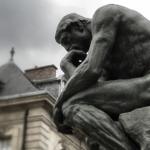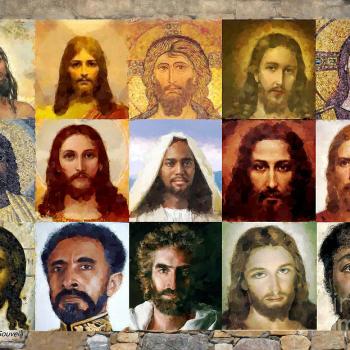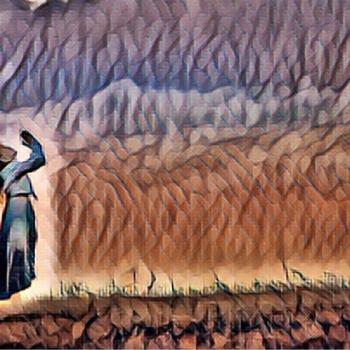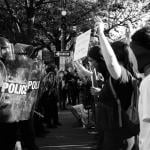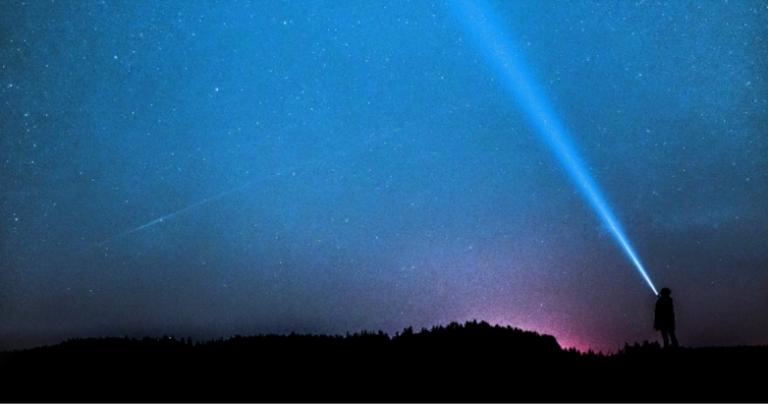
“We believe in taking down the barriers, but we also believe in the most energetic reconciliation among peoples by getting them to know each other, talk each other’s languages, understand each other’s fears and beliefs, getting to know each other physically, philosophically, and spiritually.”
Betty Williams (1943)
Irish Recipient of the Nobel Peace Prize in 1976
Had I stayed in Iceland, I would never have become an Interfaith Minister. I would not have had to rub up against religion in my daily life, interact with people with different beliefs, examine my spiritual life in a religious context, or face my own biases. Moving to Texas pressed all of those things into my conscious awareness.
More Religious Than We Anticipated
After we arrived in the Lone Star State in 2010, my wife regularly exclaimed, “This is just like in the movies!” She was right. We had never seen yellow school buses, armed police officers, megastores with endless variety, affable individuals with southern accents, three-story interstate highways, and all the rest—except in American movies. Now, those same cinematic elements were central parts of our daily lives.
What Hollywood had severely underrepresented, however, was how religious Americans really were. Sure, the moviemakers had shown family values, but they had utterly failed to show how religion, especially Christianity, played a role in everything from playdates to politics. Plus, they never showed the rest of the world what was being said in the pews, only people going in and out of churches.
I Was Not Prepared
I had prepared myself reasonably well on all cultural fronts except this one, and that lack caused me to experience one culture shock after another. It felt like religion was on display everywhere I looked. I could not escape it. People were praying in public, asking us to come to their churches, displaying yard signs praising the Lord, posting prayer memes on Facebook, and making decisions about whom to vote for based on their interpretation of scripture.
What was this place?
Had I left the 21st Century behind?
Was I stuck in the Twilight Zone?
Within a year or so, I had become overly sensitive to the religiosity in my surroundings. A handful of jarring experiences had even aroused anti-religious sentiments in me, similar to the ones I had fostered in my youth. Why couldn’t people just keep their faith to themselves or, better yet, move on from these antiquated ways?
Did Not Happen Overnight
How did this lead me to become an Interfaith Minister? Well, it didn’t happen overnight, that’s for sure. Had I only stayed in Texas for one or two years… not been the father of two children and obliged to interact with a variety of people… been introduced to integral theory and encouraged to look at the world from a variety of perspectives… I would probably have left Texas with my biases intact.
Good People With Different Beliefs
However, when I was able to look past some of the beliefs and behaviors that bothered me, I had to admit that I was surrounded by good people. The schools were great, the family values were supportive of the way we chose to raise our kids, people were generally courteous and friendly, our neighbors were caring and helpful, the divorce rate was low, our neighborhood was relatively safe, and everyone seemed to be active in one charity or another (much more so than in Iceland). If people needed to be religious in their own way to get there—just like I had been spiritual in my own way—then who was I to judge? Plus, when I got to know people personally, I realized there was much more nuance to their beliefs than I had concluded from my initial encounters.
Could Not See My Prejudices
That’s the interesting thing about prejudice. I could not see bigotry in myself, only in others. I found myself saying, “These people… what is wrong with these people,” without stopping to investigate whether or not I was jumping to conclusions.
It was ironic, to say the least.
During my years in the New-Age movement, I felt how hurtful it could be to be mocked by people who had not taken the time to learn about my nuanced beliefs. Now, I was making that same mistake, judging without investigation.
Seeing the Whole Person
After making that rather distressing realization, I changed course. In every exchange, I attempted to apply an integral paradigm, to see the whole person, the entirety of their belief system, and the context of their cultural surroundings before I came to any conclusions. Adopting this new mindset took longer than I had anticipated, but little by little, it did improve my relationships with Texans of all sorts.
We lived in Austin for the first few years—which is more culturally diverse than rural Texas—so, in addition to the conservative Christians I befriended, I made Hindu, Jewish, Muslim, Buddhist, agnostic, and atheist acquaintances with beliefs and customs very different from my own. I did not agree with them on all fronts (still true to this day), but I was happy to socialize with them and let their kids play with my kids. Through our many interactions, a common denominator emerged.
No Substitute for Rubbing Shoulders
My pluralistic self shudders to admit that I had subconsciously anticipated something different, which was evident by my relief. Despite my many proclamations of postmodern inclusivity, growing up in a homogenous country like Iceland had not prepared me for living in a multi-cultural and multi-religious society. There is no substitute for rubbing shoulders with people of all kinds.
What Do People Believe?
Amidst this variety and devoutness, I found myself wanting to know more about what people believed and how that translated into behavior. I started following religious demography to get a clearer picture. That was the first time I heard about the demographic Nones, a term used to identify people who answered ‘none of the above’ to questions about religious affiliation. As it turned out, the Nones were the fastest-growing demographic group in America and already outnumbered Evangelicals.
Could I Serve the Nones?
Speculations ensued. Could I somehow combine interests? Serve the Nones, especially those who wanted to be spiritual without belonging to organized religion, and learn about other people’s beliefs in the process? What would that look like?
It took me several years to digest those questions after they first surfaced in 2012. It wasn’t until after I wrote two novels inspired by my spiritual struggles—both of which were published in 2016—that I was ready to look for answers.
By that time, I had weaned myself off guru aspirations and ditched my persistent mirage of eventual perfection. What I had left was my love for spirituality, a growing interest in religion, and an innate wish to be of service. After wide-ranging explorations, I concluded that ministering was the only profession that would allow me to nurture those interests.
Really?
Me?
A minister?
It felt like I had seen a tiger in Africa.
Except, this wasn’t entirely out of the blue. My public speaking career had caused several friends to suggest that I should become either a minister or a politician. Still, I wavered. I did not want to fall into the premature holiness trap again. If I ever became a minister, I had to approach that role in a down-to-earth manner with a focus on being of service rather than portraying myself as a role model.
Could I Be an Interfaith Minister?
When I finally came upon the title of Interfaith Minister, I was intrigued. Did that mean I could minister to people of all faiths, including all forms of spirituality, and use my love for pluralism and integral thinking to bring people together?
I dove into research mode headfirst.
Several seminaries across the States were offering this kind of training, and the curriculums looked like they had been designed for my interests. Seminarians learned about the world’s religions, spiritual counseling, wedding celebrations, end-of-life traditions, mystical practices, church building, and the lived religion of others.
The only thing that wasn’t entirely clear was what an Interfaith Minister would do once the education was over. No churches were hiring such ministers, only a few organizations recognized them as chaplains, and people weren’t looking to them in droves for spiritual counseling. Nevertheless, the websites said that Interfaith Ministers were already making a difference in everything from the wedding business to spiritual workshops and community organizing. As I saw it, the field was being shaped, and the possibilities were endless.
Never Instead Of…
In the summer of 2016, I signed up for a yearlong course at All Faiths Seminary International. The school operated under the motto “Never instead of, always in addition to,” and was founded in New York by Rabbi Joseph Gelberman, a man who had worked tirelessly on improving interfaith relations and had been a good friend to Swami Satchidananda, the founder of Yogaville in Virginia, one of Swami Sivananda’s disciples (another personal connection for me, since Yogi Hari was twice removed from Sivananda). Sadly, the Rabbi passed away in 2010. Having seen his videos and read his writings, I know I would have enjoyed meeting him.
Studying at the seminary was enlightening, challenging, and educating, all at the same time. I learned more about other people’s beliefs than I ever had and added new puzzle pieces to my integral understanding of religion and humanity. As with all growth, the process was neither linear nor straightforward. Sometimes, it was borderline infuriating. I entered the program with many preconceptions. Some were corroborated. Others were severely challenged. No matter what I encountered, though, I kept pushing the boundaries of my worldview.
Two Books
Two books became central to my studies.
In The World’s Religions (required reading), Huston Smith approached the topic of religion like a music appreciation class, focusing on beauty and diversity. With every chapter I read, my appreciation for the religions of the world grew. I soon realized that there was an inextricable link between religion and spirituality. The connection simply ran too deep to completely sever one from the other. That was when I stopped calling myself non-religious.
In Perennial Philosophy (my book of choice), Aldous Huxley peered much deeper and examined the underlying mystical elements that tied the world’s wisdom traditions together. I was struck by how many similarities he had unearthed.
Paradoxical Insights
By early 2017, my explorations had yielded several integral insights into the nature of religion. Somewhat surprisingly, the big picture that emerged turned out to be paradoxical. The religions of the world were both the same and not the same.
- They were not the same because they derived from different cultures, told different stories, practiced different customs, and had different ideas about life, the universe, and everything. Trying to equate people’s affinity and antipathy for clothing, food, human behavior, and other religious do’s and don’ts was futile. There were just too many material and cultural perspectives for any universal rules to emerge. Realizing this weaned me off the erroneous pluralistic idea that all religions were essentially saying the same thing.
- They were the same when experience was the focal point rather than dogma, culture, or rituals. I found that comparing the writings of Islamic Sufis with the writings of the Hindu Yogis, comparing the teachings of Christian Mystics with Jewish Kabbalists, and comparing all of it with various practitioners of Buddhism—just like Huxley had done—exposed several parallels.
Most importantly, the scholars I was studying underlined the importance of human experience. Huston Smith wrote that one could “define theology as the systematization of thoughts about the symbols that religious experience gives rise to” and added that religion was, in fact, “institutionalized spirituality.”
Experience Was Central
In The Varieties of Religious Experience, William James asserted something similar. Most religions were born because of one person’s religious experience, he said. However, if his or her theology spread and survived persecution, it became orthodoxy, at which point its days of “inwardness” were over because orthodoxy effectively stopped “all later bubblings of the fountain from which in purer days it drew its own supply of inspiration.”
Muslim theologian Al-Ghazali succinctly affirmed the importance of experience when he wrote, “there is a big difference between knowing the meaning and causes of health and satiety, and being healthy and satisfied.”
And Universalist clergyman Hosea Ballou tied it all together in practical terms when he said, “There is one inevitable criterion of judgment touching religious faith in doctrinal matters. Can you reduce it to practice? If not, have none of it.”
Practice.
Experience.
Those were the elements I had been pursuing all my life. I was thrilled to see that both were closely related to religion. After making this connection, two equally important experiential paths emerged in my mind. I called them the paths of Oneness and Goodness.
Oneness and Goodness
The path of Oneness appeared to be reserved for the few, the monks, nuns, and ascetics of every tradition, people willing to set aside material longings, transcend the physical and mental planes of existence and merge with the nondual or transcendental essence of everything. No matter where adherents began their journey, once they entered the realm of oneness experientially, their writings became almost synonymous, confirming Meister Eckhart’s claim that “Theologians may quarrel, but the mystics of the world speak the same language.”
On the other hand, the path of Goodness appeared to encourage practitioners to be good within the confines of the dualistic world, to increase their capacity for love, compassion, forgiveness, and service. Aside from preaching the universal ethics of reciprocity (the Golden Rule), the religions of the world had very different ideas about how to do that. However, on this path, it also appeared that the more altruistic adherents became, the more similarities I found between their actions and writings.
Epiphany: Is 8 the Number of God?
I was both elated and perplexed by this insight. At first glance, these two paths appeared to be at odds with each other. Nonetheless, both appeared in one form or another in all of the world’s religions. How could they be equally valid?
The answer came to me soon after that.
Rabbi Paris, the president of our seminary, was giving a lecture on Judaism. Almost in passing, he said that the number 8 was the number of God. My initial reaction was to brush it off as utter nonsense. Why would God prefer one number to another? It was ridiculous.
Moments later, I had an epiphany. Turned sideways, the number 8 equaled the infinity symbol (∞), the symbol of Brahman, the One without a Second. I was reminded of the Upanishad passage that said, “Out of himself he brought forth the cosmos and entered into everything in it.”
I saw it clearly.
Nondual Oneness was represented on the left side of the infinity symbol, flowing into and creating the material universe on the right side, then flowing back into Oneness as it dissolved, creating an endless loop. Duality was represented on the right side, signifying material diversity, where humans were given choices between harmony or struggle, creation or destruction, and good or evil. Over time, human preferences had been codified in religion and presented as either moral aspirations (be good, compassionate, loving, and work towards harmony) or rules of restriction (don’t do this, don’t do that… or else).
Experifaith Model
That was how the foundation of my Experifaith model and final thesis came to life. In my own way, I had tied the mystical and moral aspects of the world’s religions together through human experience. Most importantly, though, I could show (myself mostly, because this solved a persistent internal struggle) how the two opposite paths were separate yet connected.
My thesis was well received at the seminary and generated many interesting discussions. During our weeklong retreat in upstate New York, I especially enjoyed my one-on-one conversations with Rev. Jon Mundy. We talked about all manner of mysticism and theosophy, going deeper than most. It was a meeting of minds.
Becoming Ordained and Serving Others
On June 17, 2017, I was ordained to become an Interfaith Minister during an uplifting and inspiring ceremony at a beautiful Manhattan church. Even crowded subway trains and delays could not wipe the smile off my face as I traveled to my hotel that evening.
The day after, while waiting at the airport on my way back to Texas, I started thinking about how to use my new role to benefit others. Numerous avenues appeared open. I could become an interfaith wedding celebrant, use my Experifaith model to help people combine their interspiritual beliefs, serve as an interfaith chaplain for those in need, or create my own church.
Being Human
As I pondered my future, a piece was added to the puzzle.
On Fareed Zakaria’s Sunday morning talk show, shown with closed captions on the terminal TVs, panelist Padraig O’Malley, who had been instrumental in the Northern Ireland peace process, pointed out that we all have two personas, the human and the ideological. He said that the only way to dehumanize someone was to start seeing him or her as an ideologue only, adding that a cultural overemphasis on ideological differences could diminish our shared humanity and create a vacuum for violence.
The wheels in my head started turning. If experience was at the heart of religion—like I had maintained in my Experifaith model—then being human was at the center of it all.
Why did it take me so long to get there? Being human was what all religions had in common. That was the connection, the linchpin, the cornerstone, the foundation. We were all human first, ideologically diverse second. Could such an understanding be the answer to reducing some of the societal divisions tearing my adopted country apart? If people could put aside their ideological differences, even for a moment, and earnestly see each other’s shared humanity, would we not be better off as a whole? The notion was exhilarating, but the problem it exposed felt absolutely overwhelming.
Co-Human Harmony
Having laid under a pelt for a couple of months—monitoring my frustrations, seeing public tensions boil over again and again, contemplating possible solutions—I started working on an approach to accomplishing social harmony.
At the center of my efforts was O’Malley’s simple idea of the two personas, the human and the ideological. The human persona is what we all have in common. We are born, we die, we laugh, we cry, we eat, dream, dare, and bleed—all of it tied together by the basic Maslow needs (physiology, safety, belongingness, love, and esteem). The ideological persona contained an endless variety of beliefs and values, every -ism one can think of.
As I saw it, achieving social harmony meant focusing on the co-human elements first, something I had learned through my interactions with neighbors in Texas, and then respecting ideological differences, so long as they did not deny someone else’s humanity. My central argument was that instead of trying to make all ideologies equally important, which was what pluralism sometimes did, honoring other religions meant honoring the people who practiced them.
Interfaith Experiences Supported My Theory
My involvement with the Austin interfaith community underlined this concept. We spent little time discussing the details of our religious beliefs during dialogue sessions. Instead, we talked about our hopes, dreams, fears, and similarities. We got to know each other as human beings. Those kinds of interactions then created respect that transcended ideological differences. Once friendships were made, learning about other people’s beliefs came naturally. I brought my family to several interfaith events, and we always walked away with a stronger sense of shared humanity.
Hard Message to Get Across
This idea of co-humanity appears simple, yet getting the message across has been anything but. Too many people want to be angry and stew in their righteous ideological rage these days. Still, I have not lost hope.
My rationale for that optimism is simple. When more people are ready, when the pain of acrimony has become unbearable, then we who call ourselves the bridge-builders, healers, and harmonizers of the world can come in off the sidelines and be both prepared and able to assist. To keep myself from losing faith, I have to keep reminding myself that drops create ripples, however minor.
What Does an Interfaith Minister Do?
Having had time to reflect, it means three things to be an Interfaith Minister, depending on the context.
An Interfaith Minister:
- Facilitates better relationships between people who adhere to different faiths and ideologies.
- Serves people’s spiritual needs by assisting with everything from spiritual care to weddings to end-of-life celebrations.
- Helps people who want to be spiritual in their own way (a.k.a. interspiritual) organize their beliefs so they do not create constant inner battles.
Improving relations has been at the heart of my work thus far, but I am growing into the other two areas.
* This article was curated from my memoir titled Spiritual in My Own Way
Gudjon Bergmann
Author, Coach, and Mindfulness Teacher
Amazon Author Profile
Recommended books:
- Monk of All Faiths: Inspired by The Prophet (fiction)
- Spiritual in My Own Way (memoir)
- Co-Human Harmony: Using Our Shared Humanity to Bridge Divides (nonfiction)
- Experifaith: At the Heart of Every Religion (nonfiction)
- Premature Holiness: Five Weeks at the Ashram (novel)
- The Meditating Psychiatrist Who Tried to Kill Himself (novel)
Picture: CC0 License


